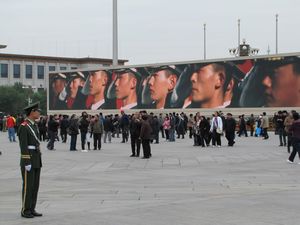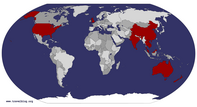Advertisement
Published: October 23rd 2010

 Speaks a thousand words
Speaks a thousand words
The propaganda machine in full flightThe first class train ride to Beijing took about 10 hours, but turned out to be reasonably comfortable. At one point we were zipping along at the snail pace speed of 167 km/hr and we were briskly overtaken by one of the bullet trains, by the time I had turned to Chris to point out the white blur it was already gone. Even though it would have been really good fun to take the fast train, and obviously a lot faster, it would have been a shame to miss the scenery.
Well, we arrived in Beijing - OMG - how flippin’ cold is it here. But of course because we arrived in the evening it would only be cold during the night - stands to reason!!!! Our chosen hostel for our stay here was the Red Lantern House. Luckily we took a taxi otherwise we would never have found it as it was down an obscure little road behind a non-descript door, but when we got inside it really looked the part with red lanterns (hence the name we thought - still quick) hanging all around the communal area creating a lovely contrast to the dark wood and water features.

 Watch out Behind
Watch out Behind
There might be a tankBut still cold. Bed was a bit like sleeping on a board, but good for our backs! The free breakfast, because we had paid for 5 nights, was crap but hey it was free.
The following morning as we headed out to Tian’anmen Square we soon realised that the cold of the night before wasn’t just because it was night time; it was in fact bloody cold and we hadn’t packed all the necessary woollies. The metro turned out to be easy to navigate and we soon found ourselves walking into the infamous square having first passed through security, causing a slight bottle neck as literally thousands of people thronged to the symbolic heart of China. Immediately our minds conjured up that vision that everyone remembers of the tanks rolling in opposed by a solitary student, which is at odds to its intended purpose which was a space for mass declarations of loyalty. The square is vast, covering some 40 hectares, and is carefully guarded on all sides by the might of China, both past and present. At one end of the square stands the entrance to the imposing Forbidden City, which has been the home to 24 emperors,

 A sign of things to come
A sign of things to come
in the UK if the TUC have their wayand at the opposite end is the Chairman Mao Memorial Hall. Luckily for us the memorial hall was shut by the time we arrived which saved us having to make the decision whether or not to view the pickled corpse of the revered leader; seems a shame that his remains lay in this ugly building as he actually wanted to be cremated. Flanking the other sides of the square are the Great Hall of the People, the Museum of Chinese History and the Museum of the Revolution; all large and imposing and demonstrating just the right amount of political power. Just in case all these monumental buildings weren’t enough to make the weak cower, there are permanent large screen displays in the square showing how happy the workers are toiling in the fields and offering impressive displays of the country’s military might. It was a bit surreal standing in the middle of the square and taking in all its violent history amidst the throngs of Chinese people happy snapping all over the place, the undercurrent was “Smile, or we arrest you”.
After negotiating the square and one form of power display we made our way down to Qianmen, another
display of power - the power of capitalism. The first thing we saw, thank goodness, was Starbucks, as we were desperately in need of something warm to thaw us out. How bizarre is that, one minute we are quaking under the might of communism and the next we are having a hot chocolate in Starbucks! The entrance to the district begins with a beautiful 15th century double arched gate and red lanterns interspersed amongst flower pots frame the facades of some very expensive shops. Walking along the parallel road is where all the action is and the road is cramped with small tourist shops, selling all manner of souvenirs, providing tasty morsels to eat and most importantly woolly hats. One duly purchased and Chris felt he could at last go on.
Some 2km down this road and we found ourselves in the Ming designed Temple of Heaven, otherwise known as Tiantan. It used to be the centre of imperial ceremony and symbolism and was firstly built in the reign of Emperor Yongle (although it was faithfully re-created later after the original was burnt down) and symbolises the meeting point of Heaven and Earth. Heaven was considered round, so the

 Heavenly Harvest
Heavenly Harvest
The place to plead for a good onetemples are circular, and Earth was considered square, so the temple and altars sit on square bases. The Emperor was considered an intermediary between Heaven and Earth and so it was him who performed the most important ceremony of the year here; praying for the year’s harvest. At that time the common people were not allowed to even glimpse the procession heading towards the temple and now they let all us happy snappy tourists in - how times change. The main temple building in the complex is the Hall of Prayer for Good Harvests, which is an absolute wonder especially when you consider that it is made completely of wood without a single nail to hold it all together. The outside of the temple is blue, green and gold with a dragon motif continued all around which is simply beautiful and the inside is just as stunning although you have to fight your way through the throngs of people to catch a glimpse. The complex is a stunning creation and appropriately named the Temple of Heaven, as heavenly it was.
A quick shop in a local supermarket meant we could both ensure we had all the necessary woollies (namely

 Beautiful Designs
Beautiful Designs
and a prayer wheel in the roof toohats and gloves) for the rest of China. It was here that we caught a glimpse of a sign which made us chuckle. On the way down an escalator under a low ceiling the sign proudly announced “Watch your hair”! It is obviously okay to knock yourselves senseless but for goodness sake don’t mess up your hair.
The next historical site on our itinerary was the Forbidden City, or Imperial Palace, or the Gugong (whichever you want). From inside 24 emperors of the Ming and Qing dynasties issued commands and laid down the law with absolute power. Common Chinese were not even allowed to approach the walls. Apparently it covers 100 hectares and has 800 buildings, and although we spent almost a day here ambling through its passageways unfortunately we only saw a small proportion of it. The weather was really conspiring against us today, not only was it cold but it was flippin’ raining as well and what is worse than negotiating thousands of Chinese tourists - thousands of Chinese tourists carrying umbrellas. We felt that if we could make it through the day without losing an eye we were probably doing very well. We made sure we

 Forbidden City
Forbidden City
but we can't talk about itbought an audio guide as there was so much to see and not everything is written in English, which turned out to be quite good. The only drawback was, as soon as you got near building she started talking and you couldn’t rewind, so if you just happened to be walking near a building to get to another one she started telling you all about it. It is quite hard to wax lyrical about a place when the rain and cold made us feel miserable, but it was an absolutely stunning complex. I had absolutely no idea how huge it was before we went there and wandering through its small maze like alleyways and visiting some of the buildings you could just imagine the emperors creating the laws from within that would be obeyed with absolute authority by their millions of subjects on the other side of the wall. One of the really interesting things we learned from our lovely lady on the audio machine, is that the more important the building in the complex the larger number of ugly little animals there are on the roof, so the Hall of Supreme Harmony, the most important, has the most with
11 of the little lovelies. We spent the rest of the tour counting roof decorations! It still seemed impossible to believe that we were not only in China, but in the grounds of a palace that for centuries was closed to its own citizens let alone outsiders like us - how the world moves on.
What we have realised as we have travelled through China so far, and especially visiting the historical sites in and around Beijing, are the wonderful names the Chinese have for things. The Temple of Heaven, I have already mentioned, but the Forbidden City has its fare share. For example there is the Hall of Middle Harmony and the Hall of Preserving Harmony, the Hill of Accumulated Elegance, the Palace of Heavenly Purity and the Palace of Earthly Tranquillity (where the emperor and empress apparently spent their wedding night - well let’s hope the name helped)! They certainly add to the romance.
The good thing about being back in Hostels again is meeting fellow travellers and sharing experiences, unfortunately being close to zero in the communal areas meant a bedroom with a heater and DVD’s won over being sociable.
Advertisement
Tot: 0.148s; Tpl: 0.026s; cc: 7; qc: 52; dbt: 0.0795s; 1; m:domysql w:travelblog (10.17.0.13); sld: 1;
; mem: 1.2mb

















